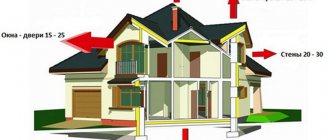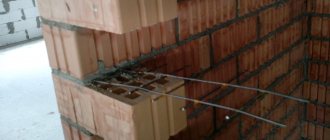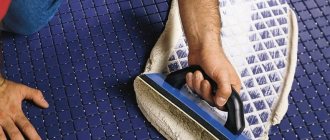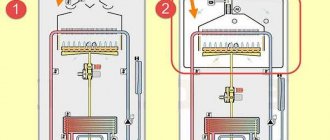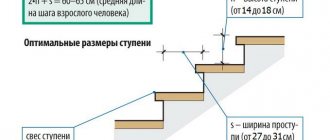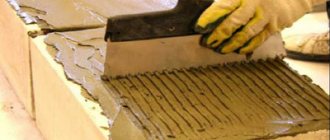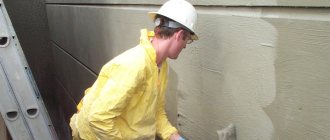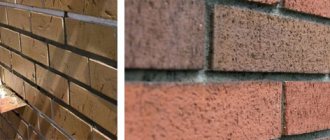The first thing every self-respecting builder does before work is to carefully calculate the consumption of mortar per 1 m3 of brickwork and the cost of all materials used in the work. When building walls, it is especially important to consider the amount of mixture leaving. If the work is done poorly, cold bridges will appear in the wall, which can be dangerous to human health, since mold likes to form there. Also, such bridges can be fraught with poor heat retention, and the amount of energy required to heat the room increases.
If you calculate incorrectly, there may not be enough material or, conversely, there may be an excess amount left. A lack of materials can lead to the fact that in the midst of work you will have to go for new ones and re-make the mixture, which will slow down the process. It's better to buy everything in advance. The remaining surplus can lie unused for years and eventually deteriorate. Anyone will be sorry for the money spent, so you should calculate everything in advance. For this you will need:
- calculation calculator;
- roulette.
For each type of construction work, different mixtures are used. For brickwork, cement grades M50 or M100 are best suited.
Types of masonry mixture
There are four main types of masonry mortar used in construction:
- Cement-sand . A classic mixture of cement, sand and water. If the proportions are correct, the solution will be strong.
- Limestone . Here, instead of cement, slaked lime is added. After drying, the seams can “go limp” from getting wet, so usually this mixture is used only for the construction of internal walls and partitions.
- Combined . That is, both cement and lime are added to the solution, which makes it possible to use the solution for the construction of external walls.
- With the addition of plasticizers . In fact, these are all three varieties indicated above, to which a liquid polymer additive is simply added, which increases the plasticity of the masonry mortar.
The most expensive ingredient in mortars is cement. Accordingly, cement-sand will cost the most, since it contains more of this binder. If the goal is to save money, then it is better to choose a combined solution, and for partitions - lime mortar.
The best option is with the addition of a plasticizer. The additive, of course, increases the cost of the solution, but not by much. Plus, the plasticity of the mixture increases, which helps to achieve an accurate thickness of the mortar layer, as well as its uniform distribution over the brickwork.
Classic masonry mortar based on cement and sand Source masteravannoy.ru
The main problem in preparing a high-quality solution is to know exactly and follow the proportions. But recently, manufacturers have made life easier for customers by offering ready-made dry mixtures that simply need to be diluted with water. Mixtures of the M50-M200 brand are suitable for laying bricks. On the packaging, the manufacturer must indicate the consumption of the solution per masonry.
Subtleties of kneading
Sand, the second important component, is also sold in bulk from bases and quarries. This material will require several times more to complete the work, so it is not practical to talk about purchasing sand by the kilogram; we will be talking about tons.
Competent specialists convince us that when mixing sand-cement mortar, it is important to make a mixture of suitable thickness that would be comfortable to work with. It is sand that gives the necessary plasticity to the solution; on the contrary, cement is very finely ground, which is why its particles are not able to significantly affect the thickness of the mixture.
Water should be poured into the solution in small portions, based on the weight, but not the volume of cement. However, you should not pour out all the liquid at once, so that later you do not have to correct the situation by mixing the components again and again by eye. The fact is that it is impossible to predict in advance how clean the sand will be, what its humidity will be, as well as the weather conditions in which construction will take place.
In addition to sand, water and cement, the mortar may contain other components: lime, clay, mixtures that help prevent the mixture from freezing, as well as additives that prevent the formation of efflorescence (whitish spots) on the walls.
Type of brick
The modern variety of bricks requires a special approach to solving the issue of mortar consumption for brickwork. And if previously wall brick, also known as ordinary brick or solid brick, was mainly used, today manufacturers offer several options.
The first one is hollow. The design of the product contains cavities, which increase the thermal insulation characteristics of the brick wall. But you need to understand that during the laying process these cavities are partially filled with mortar, which increases its consumption.
For example, a solid ordinary brick will require 0.00063 m³ of mortar. For hollow – 0.0007 m³.
Brickwork made from hollow bricks, in general, is no different Source nica-kirpich.ru
See also: Catalog of companies that specialize in the construction of brick houses
The size of the bricks also influences the consumption. Today, three types are used in construction:
- single with dimensions 250×120×65 mm;
- one and a half – 250×120×88;
- double – 250×120×138.
Here the ratio is as follows - the smaller the dimensions, the greater the consumption of mortar per cube of brickwork. In this case, it is necessary to take into account the thickness of the wall itself. And it can be half a brick, a brick, two stones or two and a half. There is no need to make it thicker.
So, if the wall is built using half a brick, then per one cubic meter of masonry, 0.189 cubic meters of mortar will be required. If the masonry is single-brick, then the consumption will be 0.221 m³. For one and a half bricks, which is 38 cm wide, the mixture consumption will be 0.234. At two – 0.24. And at two and a half - 0.245 cubic meters. Please note that the calculations were carried out taking into account ordinary ordinary bricks. And 440 pieces of it are used in one cube of masonry.
Double solid brick Source mastermario.ru
Thickness of joints in masonry
Another parameter that affects the consumption of masonry mixture. There are standard dimensional parameters for the thickness of the gaps between bricks, which craftsmen must adhere to. It is these dimensions that ensure the strength of the entire structure. Here are their parameters:
- horizontal seams should have a thickness of within 12 mm;
- vertical 10;
- longitudinal in the range of 12-15 mm;
- transverse 8-10.
It is not always possible to adhere to these indicators. Causes:
- low skill of the workman;
- climatic conditions;
- geometric unevenness of bricks.
The last reason is considered the main one. Most often, this is a criterion for excessive consumption of masonry mixture. To lay the stones evenly, you have to increase the mortar in some areas to hide the unevenness of the blocks.
So, everything is clear with the thickness of the seam. The thicker it is, the more solution you will have to use.
Thickness of joints in brickwork Source etokirpichi.ru
Tolerances for calculations
The calculator is designed to calculate walls made entirely of brick. For this reason, structures that have voids or are filled with insulation must be calculated using other methods, since the result will be greatly overestimated. Another factor influencing the result is the thickness of the seams. Let's say that a 10-millimeter gap is included in the calculation, but in practice the builders slightly reduced or increased it. In this case, the greater the volume of masonry, the greater the error in the calculation.
It is recommended to multiply the number of bricks obtained during the calculation by a factor of 1.05 - 1.07, adding 5 - 7 percent to the original quantity. This way you can insure yourself in case of detection of a defect, a battle or your own mistake.
Cement consumption
Usually, when constructing private houses, builders use cement-sand mixtures. And the main component in them is cement. Moreover, it is also the most expensive. Therefore, in order to save money again, you need to know the consumption of cement per cubic meter of brick laying.
Firstly, there is a dependence on the brand of cement that it was decided to add to the masonry mortar. Usually this is either M300 or M400. The first will have to be added in larger quantities than the second. But the second is more expensive than the first. So this indicator has little effect on saving money.
Secondly, the brand of the solution itself. The lower it is, the less cement is required. For example, there is a classic solution, which is determined by the ratio of binder to sand as 1:3. That is, to make such a mixture, one part of cement and three parts of filler are required.
Masters do this in different ways, most often using buckets. Because the specific gravity of the two materials is the same and equal to 1400 kg/m³. That is, one ten-liter bucket is filled with 14 kg of material. If you count it into bags of cement, which is 50 kg, then one bag fits 3.5 buckets. Based on this, you can accurately calculate the required number of bags.
Cement consumption for different types of mixtures Source greenbuilding.rf
There is another way. Here, the calculation of cement consumption for masonry is based on the volume of each material. To do this, take one cube of sand as the main ingredient. And the required volume of cement is calculated: 1:3 = 0.333 m³. In liters it will be 333. Or 33 buckets.
Now about the consumption of cement and mortar in general. As mentioned above, for laying 1 m³ of wall, where ordinary solid stone is used, 0.221 m³ of solution is required. And if a mixture of the classic ratio of 1:3 was used for this, then cement was added to it: 0.221:4 = 0.055 m³. Let's convert the figure into kilograms: 0.055x1400=77.
How much will it take?
When facing brick work, developers are interested in the required mixture consumption per 1 m². All standards are laid down in SNiP, but in reality it turns out that the real numbers are always higher.
The thicker the walls, the larger volume of cement mortar will be needed . For example, when building walls whose thickness is equal to a quarter of a brick, then 5 kilograms are needed per 1 m² of masonry when using M100 grade cement.
The volume of cement will decrease to 4 kilograms if you mix the mixture using M75 cement.
The consumption of cement powder will be significantly reduced when other components are added, such as limestone, marble or clay.
For example, for 1000 bricks you will need 0.9 cubic meters of cement masonry mortar . Afterwards, it is not difficult to calculate the consumption per square meter of wall of a building under construction. For convenience, you can order calculations from professional builders or use online calculators.
To learn how to calculate the amount of cement, see the video below.
Briefly about the main thing
The consumption of mortar for the construction of a brick wall depends on the type and brand of the mixture, geometric evenness, type and size of the brick, and the thickness of the joints.
Calculation of consumption during the construction of a private house is carried out either in cubic meters or kilograms.
Cement, as the main component of masonry mortar, is the main expense item in the construction of walls. Its consumption depends on the brand and the amount applied. For example, when mixing cement and sand in a ratio of 1:3, ¼ cube of the solution is added as a binder. That is 0.25 m³.
Ratings 0
How to prepare the solution - proportions and general rules
To prepare the fastening mortar for the wall being built, masons use Portland cement grade 400 or 500 and ordinary sand, sifted through a construction sieve to get rid of lumps, roots, pebbles and organic matter. Both components are combined in a ratio of 1:3 or 1:4 (cement:sand). We connect three parts of sand with one part of cement only in the case of constructing loaded architectural elements - load-bearing walls, foundations, columns. In all other cases we use a ratio of 4:1
Preparation of the bonding solution
The process of manually preparing a fastening composition for a foundation or other supporting structure is as follows:
- Pour one part of the cement into the bottom of the trough.
- Pour three or four parts of sand on top of the binding component.
- Next, stir the dry mixture thoroughly until the color is uniform, without adding water.
- At the end, pour water into the trough, focusing on the proportion: half a liter of liquid per kilogram of cement.
The composition prepared in this way is loaded into buckets and distributed to the masons’ workplaces, where the building blocks have already been delivered. The master should use the bonding mass for 30-40 minutes (maximum one hour). Therefore, the journeyman responsible for the sand-cement mixture must prepare a strictly dosed volume of solution, focusing on the area of the surface being constructed in half an hour or an hour or the cubic capacity of the ceramic blocks consumed during the same time. Moreover, this area and cubic capacity depend not only on the efficiency of the mason, but also on the type of masonry.
